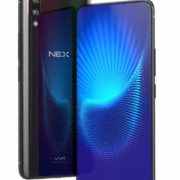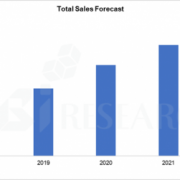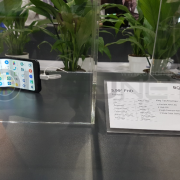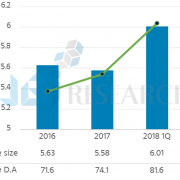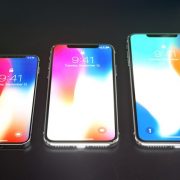2018년 2H 시작, 중국 OLED 패널 업체들의 추격어디까지?
최근 중국으로의 OLED 디스플레이 패널 생산기술 유출 사건과 관련하여 디스플레이 산업이 시끌시끌하다.
2018년 현재, 중국내 OLED 생산라인을 보유하고 있는 업체는 총 5업체로 (BOE, Everdisplay, Tianma, Turly, Visionox) 이중 삼성전자의 Galaxy와 Apple의 iPhone등 프리미엄 스마트폰에 사용되는 플라스틱 기판을 사용하는 OLED 디스플레이(“Plastic OLED”)를 생산할 수 있는 라인을 가지고 있는 곳은 BOE 한 곳에 불과하다. 다른 패널 업체들은 올해와 내년 양산을 타겟으로 Plastic OLED 디스플레이를 생산할 수 있는 라인 건설을 진행하고 있다.
2020년 말까지 중국 패널 업체들이 양산을 계획하고 있는 월 생산 Capa는 약 250K로, 현재 삼성디스플레이의 월 생산 Capa(약 180K)를 넘어서는 수준이다. 중국이 본격적인 양산을 통해 비슷한 수준의 패널을 생산하게 될 경우 생산 원가 측면에서 한국은 중국을 이길 수 없는 구조임은 분명해 보인다. 6세대 Plastic OLED 디스플레이의 주 사용 어플리케이션이 스마트폰인데 전세계 스마트폰 시장은 2015년 이후 성장이 둔화되었으며 특히 프리미엄 스마트폰 시장은 신규시장이 거의 없는 상황이다. 스마트폰과 같은 매스 어플리케이션이 개발되지 않을 경우, 머지 않아 매우 큰 과잉공급과 이는 패널 가격의 하락으로 이어져 원가 경쟁력이 없는 패널 업체는 살아남기 힘들게 될 것이다.
일단은 Plastic OLED 디스플레이 생산은 높은 기술수준과 공정 노하우 등이 필요해 한국이 상당한 기술 우위에 있는 것으로 평가한다. 하지만 산업에서는 “중국제조 2025” 전략의 일환으로 자본을 앞세운 중국 정부의 패널업체 지원이 기술 격차를 빠른 시간안에 단축시킬 것으로 예상하고 있다.
2019년까지 양산을 앞두고 있는 중국 패널 업체들 역시 최근 더욱 적극적으로 한국의 주요 OLED 엔지니어 모셔가기를 하고 있는 것으로 알려지고 있다. BOE의 Plastic OLED 디스플레이를 생산하는 청두(B7) 공장에는 약 100여명에 가까운 한국 OLED 엔지니어가 있는 것으로 알려져 있으며 GVO도 최근 고액 연봉의 중요한 OLED 엔지니어들을 수명 고용한 것으로 파악되고 있다. 초기 연구개발 단계에서부터 어려움을 겪는 것으로 알려져 왔던 CSOT 역시 작년부터 주요 공정의 한국 OLED 엔지니어들을 고용 모바일 OLED 생산 라인 구축에 박차를 가하고 있는 것으로 보여진다. 이밖에 패널업체가 아닌 HKC 역시 OLED 엔지니어들 영입하고 있다고 조사되고 있으며 이는 LCD 라인 밖에 없는 HKC의 OLED 생산 라인 투자를 위한 밑 작업으로 해석되고 있으며 HKC는 최근 티안마 OLED 사업부 합병설에 이름을 올리기도 하였다.
2018년 현재를 기준으로 아직까지는 한국 패널 업체들이 생산하는 수준의 OLED 디스플레이 패널 양산이 가능한 중국의 패널 업체는 없다. 중국 패널 업체들의 생산능력 기준과 판매 구조는 대한민국과 달라 같은 기준으로 수율을 정의 하기는 어렵지만 양산라인이라고 알려져 있는 BOE의 청두(B7)공장의 수율은 여전히 1자리 숫자인 것으로 조사되고 있다. 다른 패널 업체들 역시 올해 안에 양산라인 가동을 한다고 해도 제품 품질과 수율문제는 2019년 상반기까지도 해결이 힘들것으로 예상하고 있다.
한국 경제에 상당부분 일조하는 디스플레이 산업이 지속적으로 전세계 디스플레이 산업에서 우위를 지키기 위해서는 다양한 제품 개발, 생산과 판매 전략을 통해 경쟁력을 유지해야 할 것이다. 또한 전세계 OLED 산업의 성장을 위해 디스플레이 산업의 규모가 커지고 많은 플레이어들이 다양한 어플리케이션에 OLED 패널을 공급하기 위해서는 중국 패널 업체들의 수율 확보가 관건일 것이다.






























